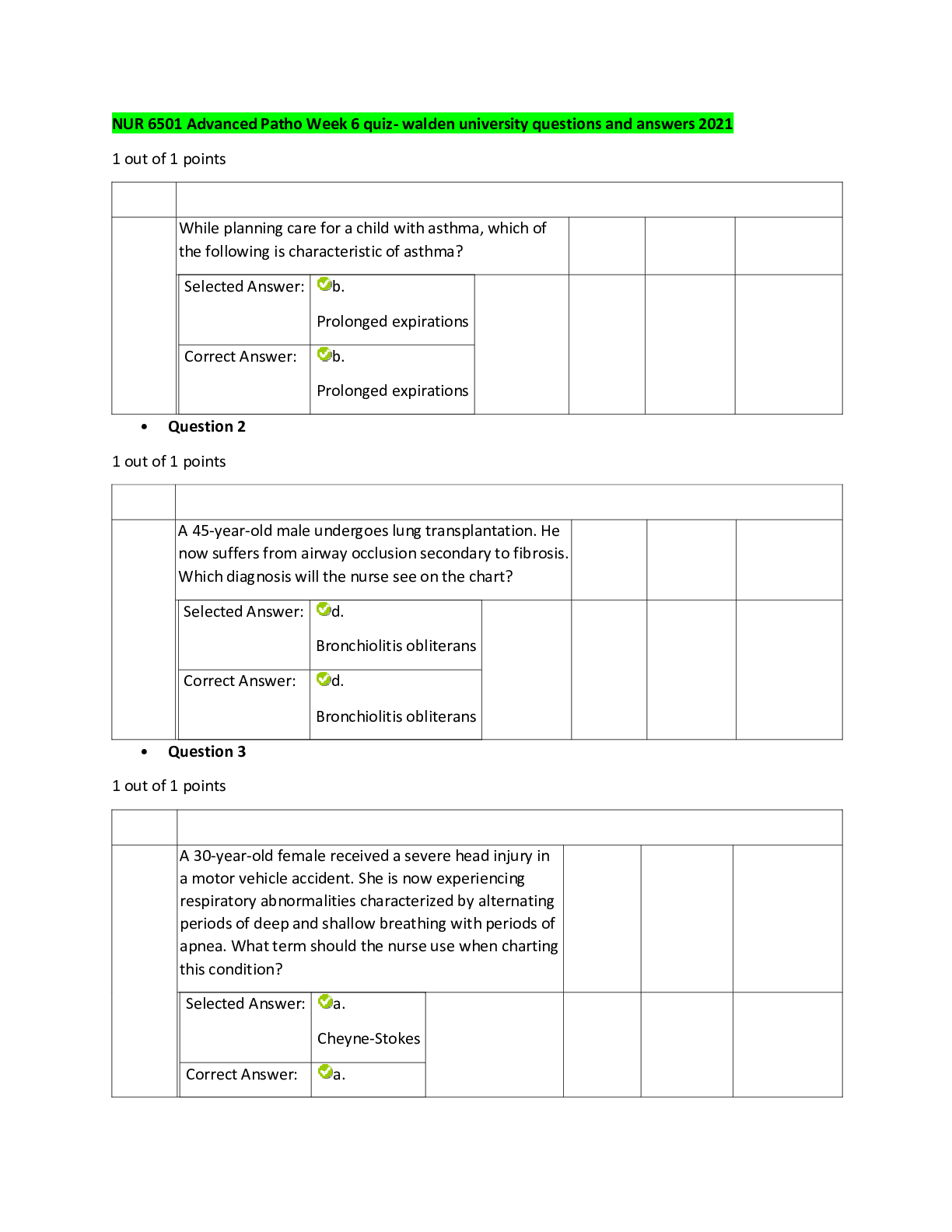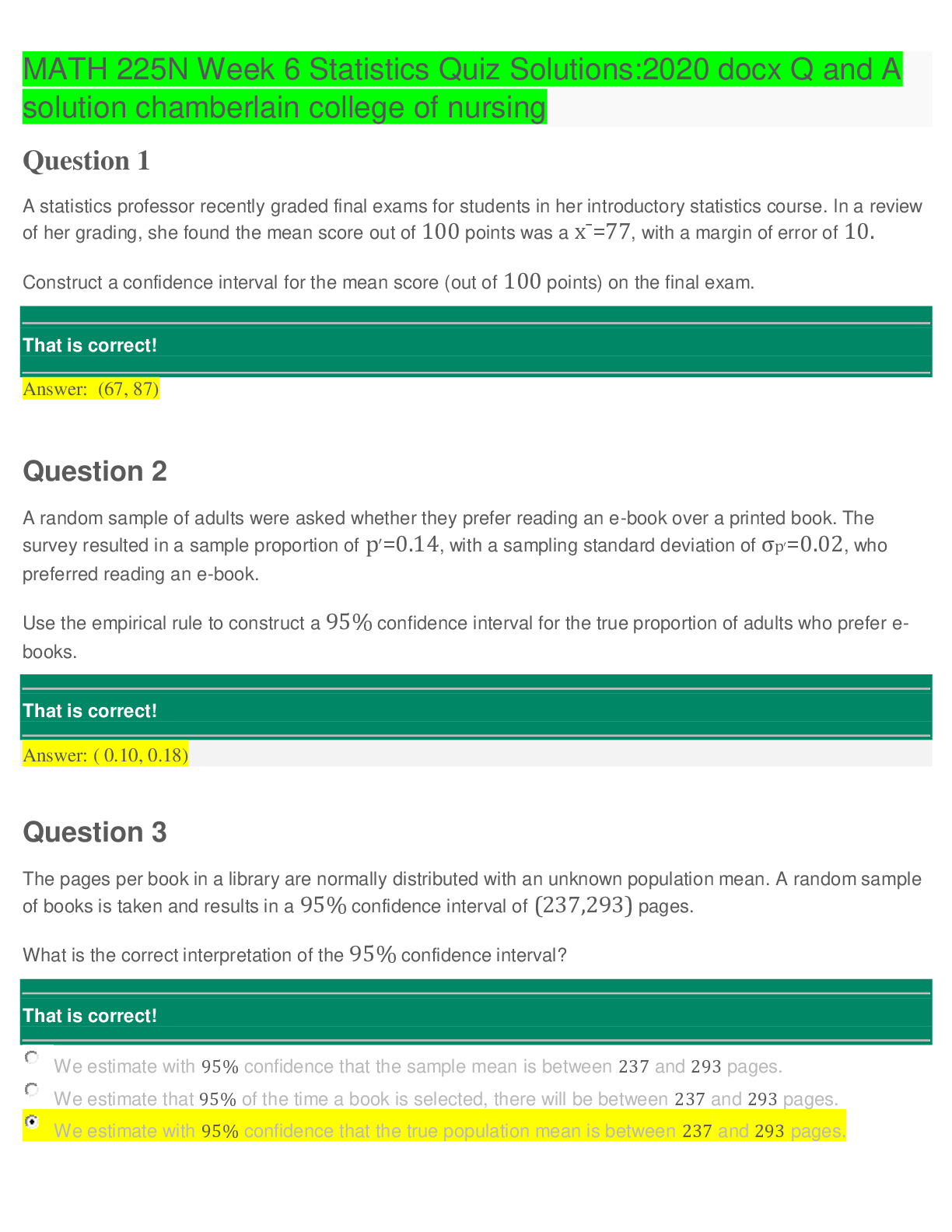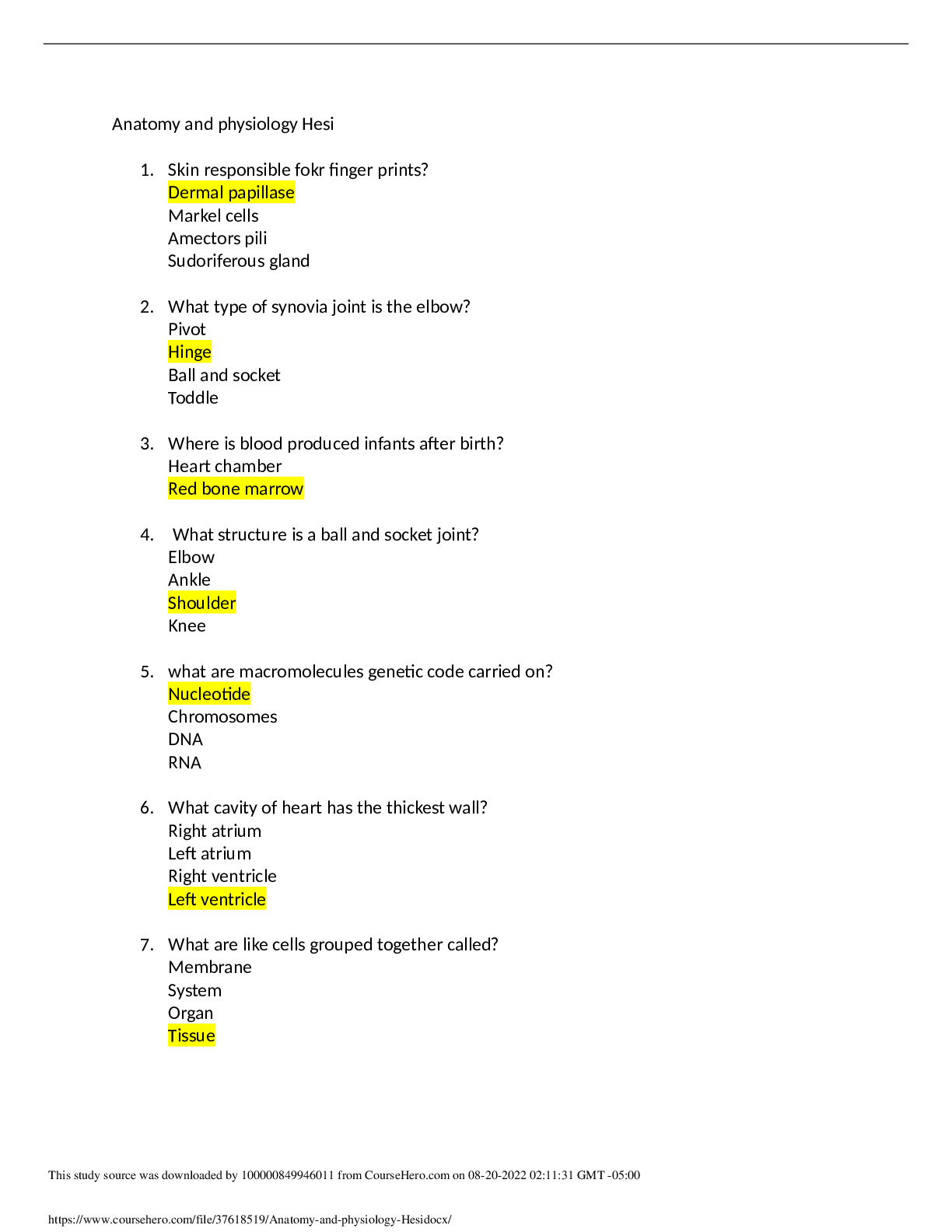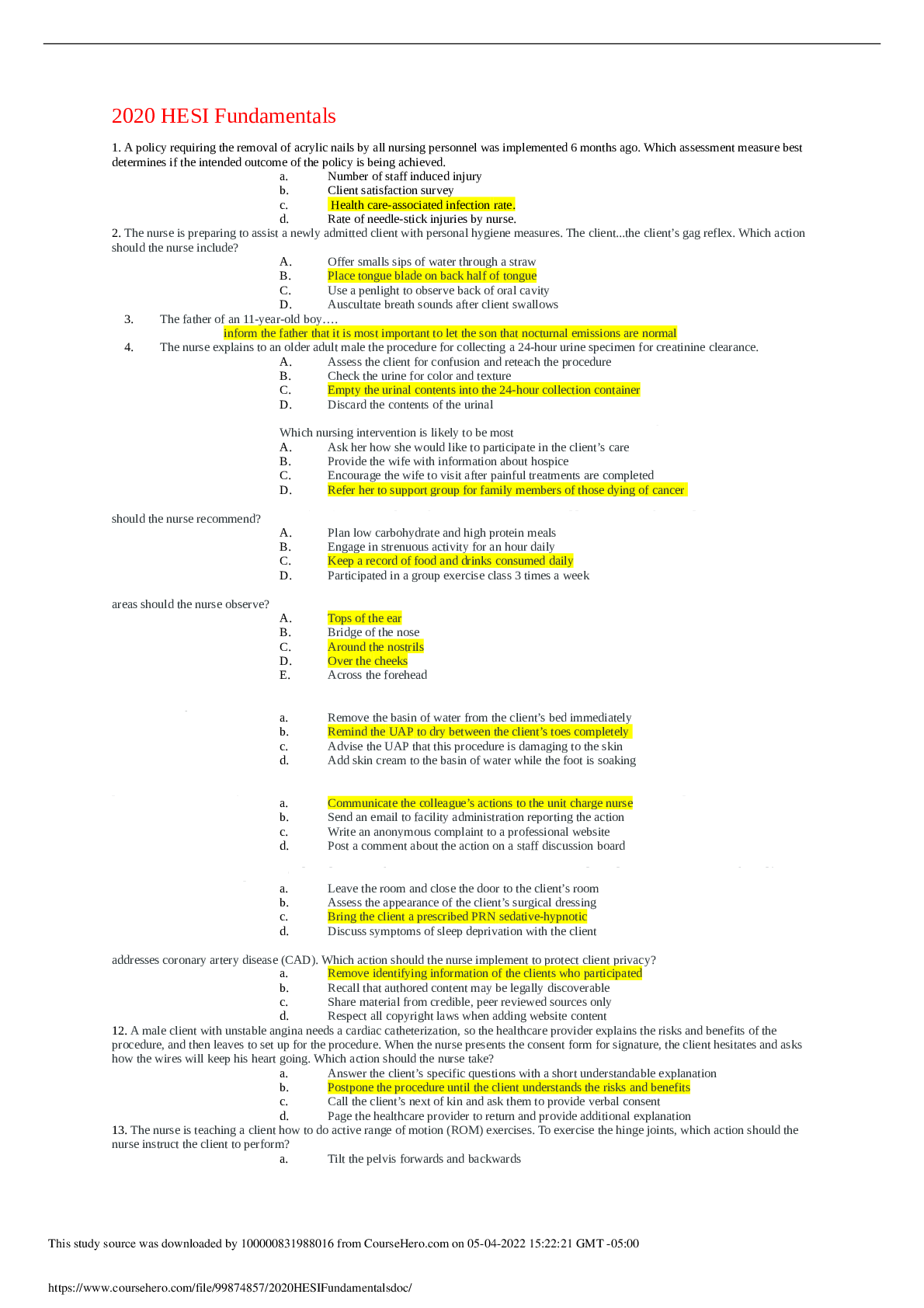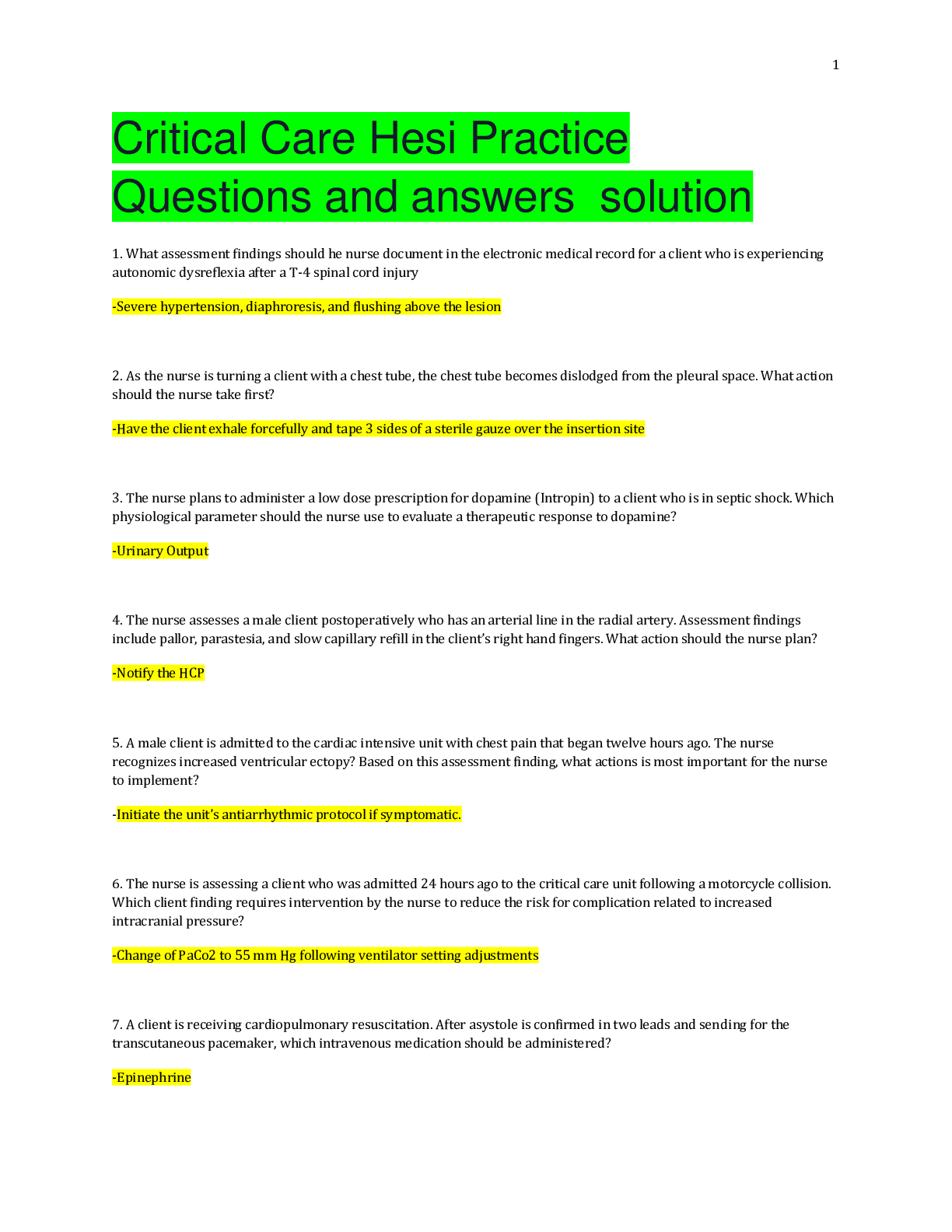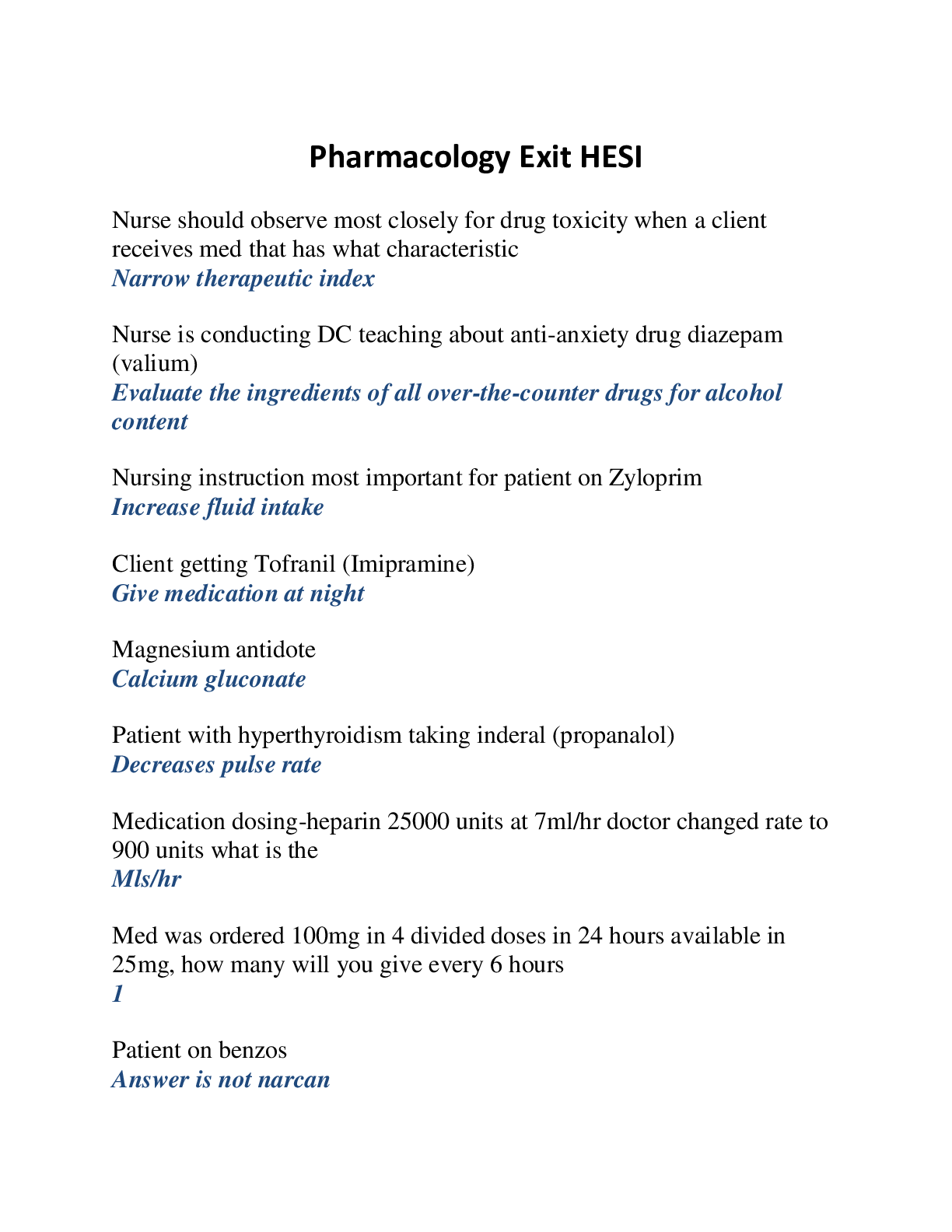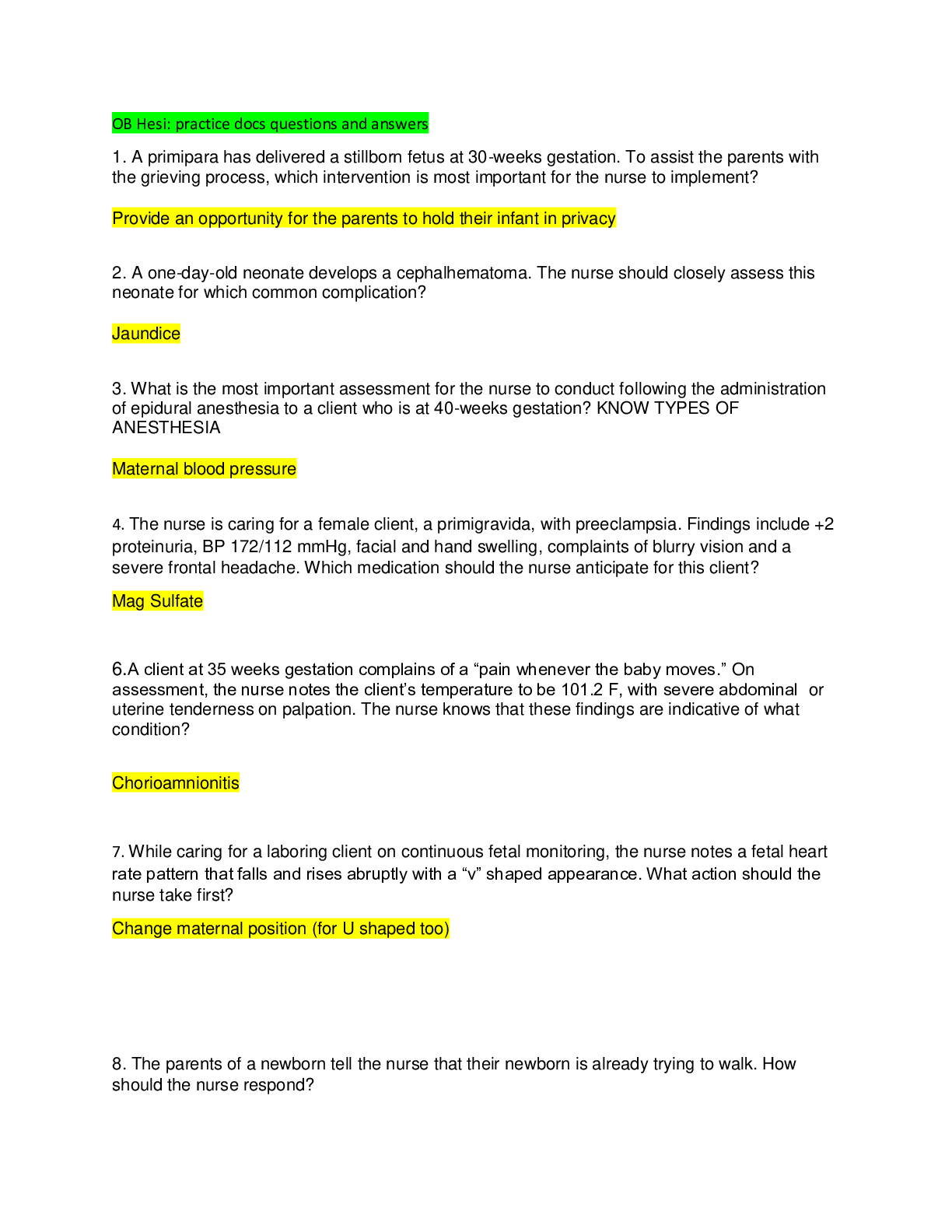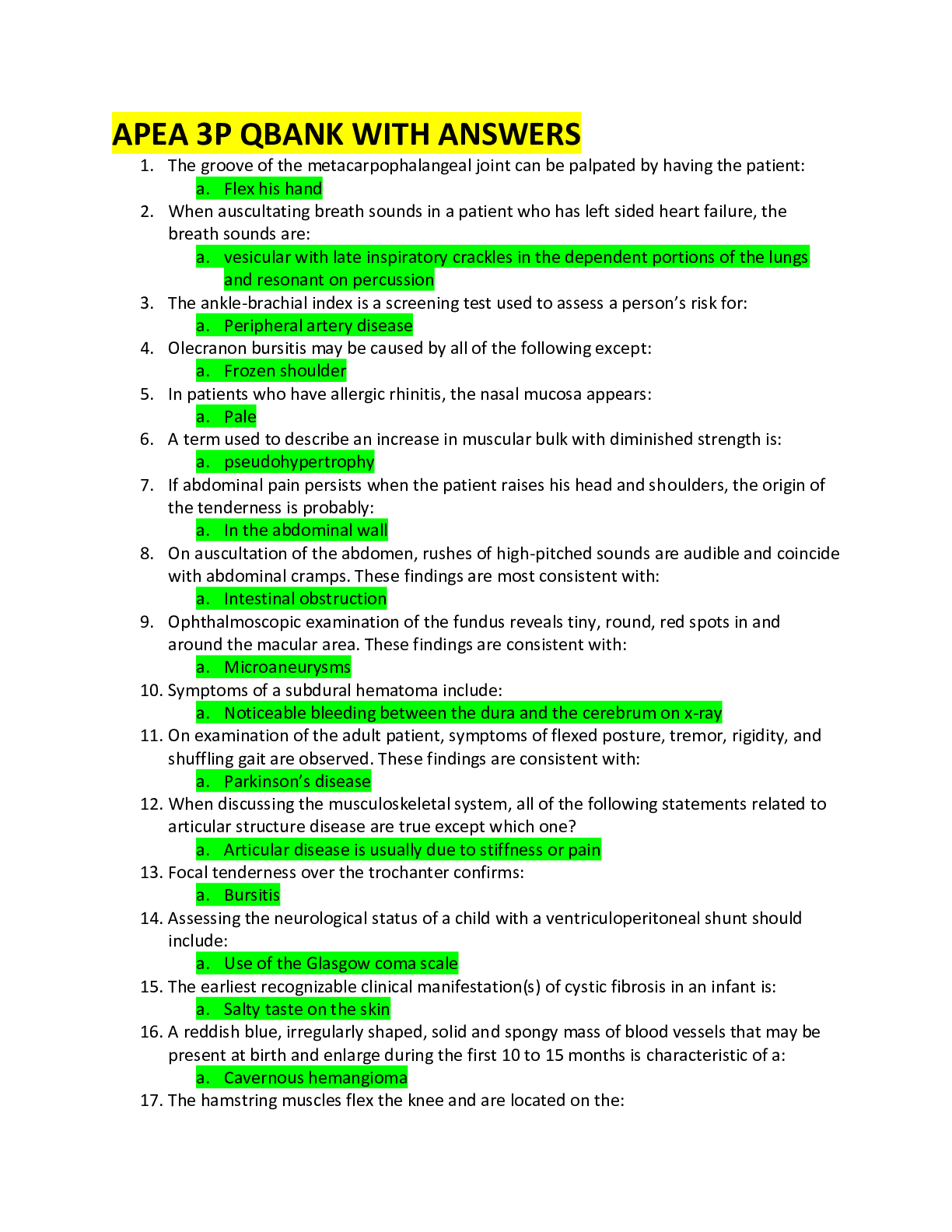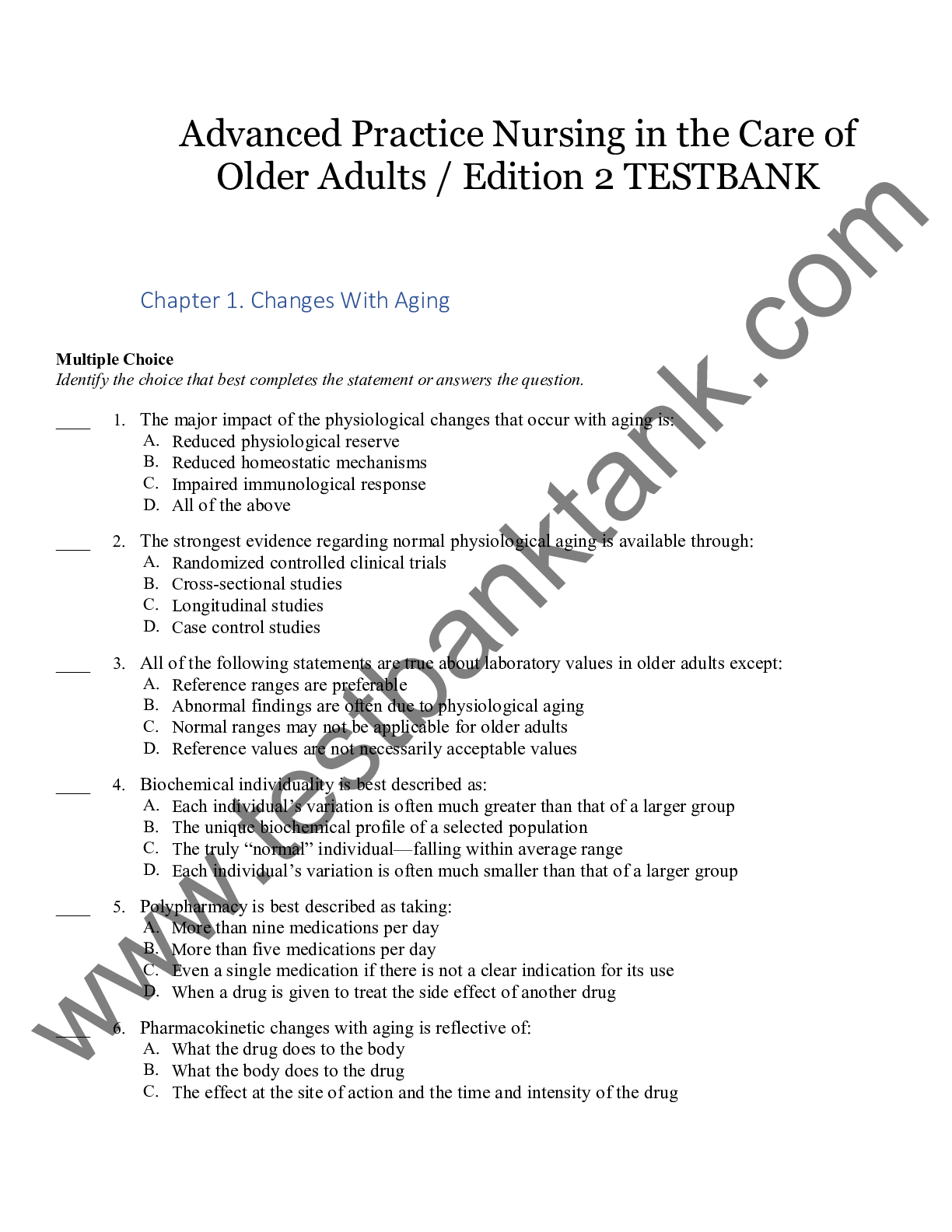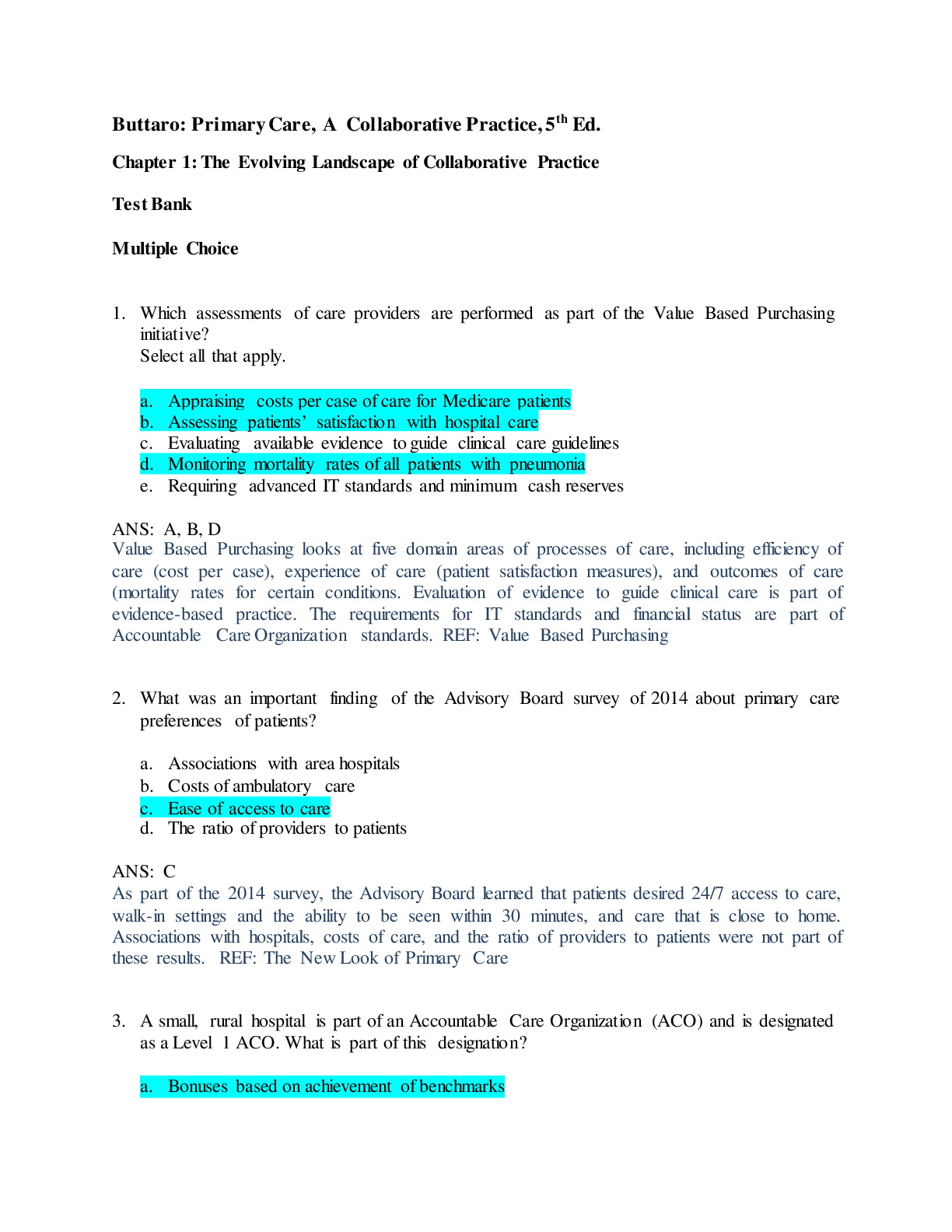Physiology > QUESTIONS & ANSWERS > PSY2012 Test Bank with answers Ch. 4 / Multiple Choice Single Select working rated docs 2020 (All)
PSY2012 Test Bank with answers Ch. 4 / Multiple Choice Single Select working rated docs 2020
Document Content and Description Below
PSY2012 Test Bank with answers Ch. 4 / Multiple Choice Single Select working rated docs 2020 1. Learning always occurs as a result of a) changing our emotions. b) experience. c) changes in ... the environment. 2. While walking down a dark alley, you jump at a loud noise. This would not be considered learning because a) it is not a behavior. b) jumping is only done for survival purposes. c) not everyone would jump in this situation. d) jumping is merely a reflex. 3. Jenna walks into her science class laboratory, and she immediately feels queasy. Today is the day her class is dissecting frogs, and she is sickened by the smell of the formaldehyde. However, after an hour Jenna is no longer sickened because of a) classical conditioning. b) habituation.c) operant conditioning. 4. Gina walks into her psychology class on the first day and she sits next to Roger. She thinks his looks are average, but by the end of the semester she finds him to be quite attractive due to a) the mere exposure effect.b) habituation. c) continuous reinforcement. 5. As an infant, Stephanie received many penicillin injections from the doctor. When she later saw a photographer in a white coat that was similar to the doctor’s coat, she started to cry. This is an example of a) instrumental learning b) observational learning c) classical conditioning 6. Pavlov placed food in the mouths of dogs, and they began to salivate. The food acted as a(n) a) unconditioned response. b) unconditioned stimulus.c) conditioned response. 7. You are sitting in a class when your professor holds up a large white feather. We could guess that most people would not really respond in any important way to the feather, because the feather is a(n) a) primary reinforcer. b) negative punisher. c) unconditioned response. d) neutral stimulus. 8. In the Pavlov study, the salivation to the tone represents the ________ after conditioning. a) unconditioned stimulus (UCS) b) orienting response (OR) c) conditioned stimulus (CS) d) conditioned response (CR) 9. When Pavlov placed food in the mouths of canine subjects, they began to salivate. The salivation was a(n) a) unconditioned response.b) unconditioned stimulus. c) conditioned response. 10. The linkage between a UCS and the UCR requires a) that the person must be hungry. b) that the individual must receive either punishment or reinforcement. c) a critical impact of insight. d) no learning. 11. Sue noticed that whenever she opened the door to the pantry, her dog would come into the kitchen and act hungry by drooling and whining. She thought that because the dog food was stored in the pantry, the sound of the door had become a(n) a) unconditioned stimulus. b) conditioned stimulus. c) unconditioned response. d) conditioned response. 12. You decide that you are going to condition your dog to salivate to the sound of a metronome. You sound the metronome and then several minutes later you give the dog a biscuit. You do this several times but no conditioning seems to occur. This is probably because a) the metronome was not a distinctive sound. b) the metronome should have been sounded after the animal ate the biscuit. c) you should have had an even longer interval between the metronome and the biscuit. d) the biscuit was given too long after the sound of the metronome. 13. After Pavlov’s dogs became conditioned to salivate at the sound of the metronome, he experimented with sounding the metronome and then failing to present the dogs with any food right away. Soon they stopped salivating to the sound of the metronome. This represents the process called a) acquisition. b) testing. c) extinction. d) spontaneous recovery. 14. One of Pavlov’s dogs had stopped salivating at the sound of the tone. The next day the tone was presented again and the dog began salivating. Pavlov referred to this as a) shaping. b) spontaneous extinction. c) stimulus generalization. d) spontaneous recovery. 15. What would you predict about Little Albert based on the principle of spontaneous recovery? a) Even after his fear of a rat was extinguished, the fear could come back. b) After his fear of loud noises was extinguished, the fear could come back. c) His fear of rats would disappear if he saw a rat without hearing a loud noise. 16. Jane’s dog will listen to her commands but ignores her sister’s commands. Jane’s dog would be demonstrating a) spontaneous recovery. b) social learning. c) insight learning. d) stimulus discrimination. 17. One outcome demonstrated by Watson and Rayner’s testing with Little Albert was that a) operant conditioning can modify behavior. b) the fear response may generalize to other stimuli. c) taste aversions can be formed in young children. 18. For Little Albert, his fear of ________ was interpreted as an instance of ________. a) John Watson; a sensible response b) a white laboratory rat; conditioned fear c) his mother; childhood psychosis d) a Santa Claus mask; experimental psychosis 19. What was the unconditioned stimulus (UCS) in the case of Little Albert? a) a rat b) a loud noise c) a high chair d) a small enclosed space 20. What could John Watson have done to eliminate Little Albert’s conditioned fear? a) Show Albert a toy dog instead of a live rat. b) Let Albert touch a Santa Claus beard repeatedly. c) Show Albert a rat many times without a loud noise following. 21. One of the best therapy strategies for eliminating conditioned fears involves combining ________ in a process known as ________. a) negative and positive reinforcement; aversion b) arousal and stress reduction; shaping c) conditioned and unconditioned responses; discrimination d) primary and secondary reinforcers; social learning e) extinction and relaxation; counterconditioning 22. An important discovery stemming from Watson and Rayner’s experiment was that a) phobias can be reversed. b) some phobias are more probable due to preparedness. c) children experience phobias more often than had previously been thought. d) phobias may be explained by using principles of classical conditioning. 23. Imagine that you have an intense fear of flying and that that you are enrolled in a counterconditioning therapy program to help you lose this fear. Which of the following situations would GREATLY interfere with the success of this therapy for fear of flying? a) Your plane develops engine trouble while you are on a short 20-minute practice flight. b) You take a muscle relaxant to calm you before the therapy. c) You are told over and over that flying is quite safe. 24. A Vietnam war veteran who hears a “call to battle stations” alarm sound last heard in heavy combat would be expected to a) demonstrate no response. b) become extremely violent. c) feel relief that they are not now in combat. d) show strong emotional arousal. 25. Last month Walter became sick after eating two chili dogs, so he no longer likes chili dogs. Walter has experienced a) blocking. b) a conditioned food aversion. c) operant taste conditioning. 26. A practical use of aversive conditioning by John Garcia was to a) cause people to look forward to receiving chemotherapy. b) dissuade wild coyotes from attacking sheep. c) make Little Albert cry at the sight of a white rat. 27. In operant conditioning, behavioral change is brought about by the manipulation of a) reflexes. b) goals. c) consequences. d) motives. 28. A child learns that whenever he eats all of his dinner, he gets a cookie for dessert. This type of learning is BEST explained by a) classical conditioning. b) operant conditioning. c) biofeedback theory. 29. When good things happen to someone, the probability of repeating the behavior that occurred before the good things increases. This best illustrates a) Heisenberg’s uncertainty principle. b) the law of effect. c) generalization. 30. According to Skinner, when you take an aspirin for your headache, taking the aspirin is a(n) ________, whereas the headache is a(n) ________. a) positive reinforcer; operant b) operant; negative reinforce c) operant; positive reinforcer 31. A grandmother gives her grandchild a cookie because the child cleaned her room. What is the cookie in this example? a) punisher b) positive reinforcer c) negative reinforcer d) conditioned response 32. Mary’s parents want her to put her books in her bookcase. At first, they praise her for putting the books together in one pile. Then they praise her for getting the books on the same side of the room as the bookcase. When she gets the books on top of the bookcase, she gets praise. Finally, her parents praise her when she puts her books in the bookcase. This is an example of a) negative reinforcement b) punishment c) extinction d) shaping 33. Bob has learned that he can usually get what he wants from his parents if he keeps whining for something. One day Bob starts whining in the toy store because he wants a G.I. Joe action figure. His father refuses to give it to him and ignores his whining. What will happen? a) generalization b) extinction c) spontaneous recovery 34. What kind of reinforcement is used if Sally’s parents give her $10 every time she accumulates six A’s on her tests? a) gradual reinforcement b) sporadic reinforcement c) continuous reinforcement d) partial reinforcement 35. Which of the following statements is true about operant conditioning? a) Neither partial nor continuous reinforcement leads to behaviors that will persist for long periods of time. b) Continuous reinforcement leads to behaviors that will persist longer than behavior learned through partial or intermittent reinforcement. c) Partial reinforcement leads to behaviors that will persist longer than behavior learned through continuous reinforcement. 36. Intermittent reinforcement is particularly effective for maintaining behavior because such reinforcement a) has popularity and generosity b) produces resistance to extinction. c) has frequency and generalizability. 37. Al must build 25 radios before he receives $20. What schedule of reinforcement is being used? a) a variable ratio schedule b) a fixed ratio schedulec) a fixed interval schedule 38. The key advantage of using a variable ratio schedule of reinforcement is that a) the person will be rewarded often. b) it is very predictable. c) it is easy to extinguish d) it produces more responding. 39. Your professor likes to give pop quizzes in your psychology class, thus she is promoting the ________ schedule of reinforcement. a) fixed ratio b) variable ratio c) fixed interval d) variable interval 40. A monthly paycheck best represents a ________ schedule of reinforcement. a) fixed interval b) variable interval c) fixed ratio 41. Using the Premack principle, once you have finished studying for your next biology test, you should a) study for at least two hours. b) study for a different test. c) work on your biology homework assignment. d) teach the biology material to a friend or classmate. e) do something you enjoy. 42. Which of the following is an example of negative punishment? a) receiving harsh criticism for lying to your parents b) losing telephone privileges for breaking curfew c) getting stung by a bee when walking barefoot outside and stepping on the bee d) getting pepper-sprayed for making a lewd comment to a stranger 43. Which of these punishments is LEAST likely to be effective? a) Claire is punished immediately for swearing at her mother. b) Dylan does not get dessert every time he fails to clear the dinner table. c) To punish Brenda for hitting, her parents take away her phone but do not spank her. d) Brandon’s parents call him a liar when he is dishonest. 44. Olivia is punished for spilling her cereal. Her parents give her a spanking and send her to her room where she cries. Later, her puppy makes a mess on the floor. Olivia kicks her puppy and puts it out in the yard, where it whines sadly. Which of the following statements explains her behavior toward the puppy? a) Olivia is correctly applying Skinnerian principles of negative reinforcement to change her dog’s behavior. b) Olivia is using negative punishment on her dog and it will change the dog’s behavior. c) Olivia is reenacting the aggressive behavior her parents demonstrated to her. 45. The cognitive view would argue that learning a) always changes both behavior and thinking. b) does not always change behavior, but it always produces changes in mental activity. c) does not always change thinking, but it always produces changes in behaviors. d) produces changes in mental activity that cannot be objectively examined. e) always involves either reward or punishment. 46. Studies of observational learning demonstrate that a) nonhuman species cannot learn by imitation. b) learning can occur in the absence of personal experience. c) television viewing has more influence on behavior than direct observation of live events. 47. A girl learns that whenever her brother shares his cookie with her, her mother gives him a piece of candy. The girl starts sharing her treats with her friends when they come over in the hopes of getting a similar reward. The girl’s learning to share is an example of a) classical conditioning b) operant conditioning c) contingency theory d) observational learning 48. In the 1980s, the Wendy’s company had an adorable lady calling the pitch line “Where’s the Beef?” This became the logo of the hamburger chain, and as people loved this older woman they came to visit Wendy’s locations with greater frequency. This demonstrates the importance of ________ conditioning for consumers and businesses. a) extinction b) higher-order c) evaluative d) operant 49. A research study by Barlett and others (2009) examined how students behaved when playing a violent video game (Mortal Kombat) or a nonviolent game. They found that students who played the violent game were willing to do which of the following? a) Consume higher amounts of alcohol when given permission to drink. b) Choose to get paid more for participating even though they knew others would be paid less as a result. c) Write a letter of complaint to a consumer company that included more profanity. d) Administer more electric shocks to a helpless animal in a cage. e) Force others to swallow larger amounts of hot sauce. 50. A procedure called desensitization utilizes the learning principle of ________ to help people overcome a phobia. a) extinction b) discrimination c) generalization d) higher-order conditioning e) conditioned emotional responses [Show More]
Last updated: 1 year ago
Preview 1 out of 26 pages
.png)
Buy this document to get the full access instantly
Instant Download Access after purchase
Add to cartInstant download
We Accept:

Reviews( 0 )
$8.50
Document information
Connected school, study & course
About the document
Uploaded On
Dec 05, 2020
Number of pages
26
Written in
Additional information
This document has been written for:
Uploaded
Dec 05, 2020
Downloads
0
Views
185

